Research Report on Homelessness in Canada - COMM19999, Win2018 Project
VerifiedAdded on 2023/06/14
|5
|1407
|189
Report
AI Summary
This research report delves into the multifaceted issue of homelessness in Canada, drawing upon various sources to explore its prevalence, causes, and impact on vulnerable populations. It highlights the challenges faced by Aboriginal northerners, the correlation between drug addiction and homelessness among youth, and the limitations of current government policies that focus on service provision rather than addressing the root causes. The report also examines the unique challenges of homeless women in Canada's northern territories, including mental health issues, trauma, and social exclusion, as well as the often-overlooked issue of rural homelessness in Western Canada. Ultimately, the report underscores the need for comprehensive and culturally appropriate solutions that address the systemic factors contributing to homelessness and support the well-being of those affected. Desklib provides access to this and other solved assignments.
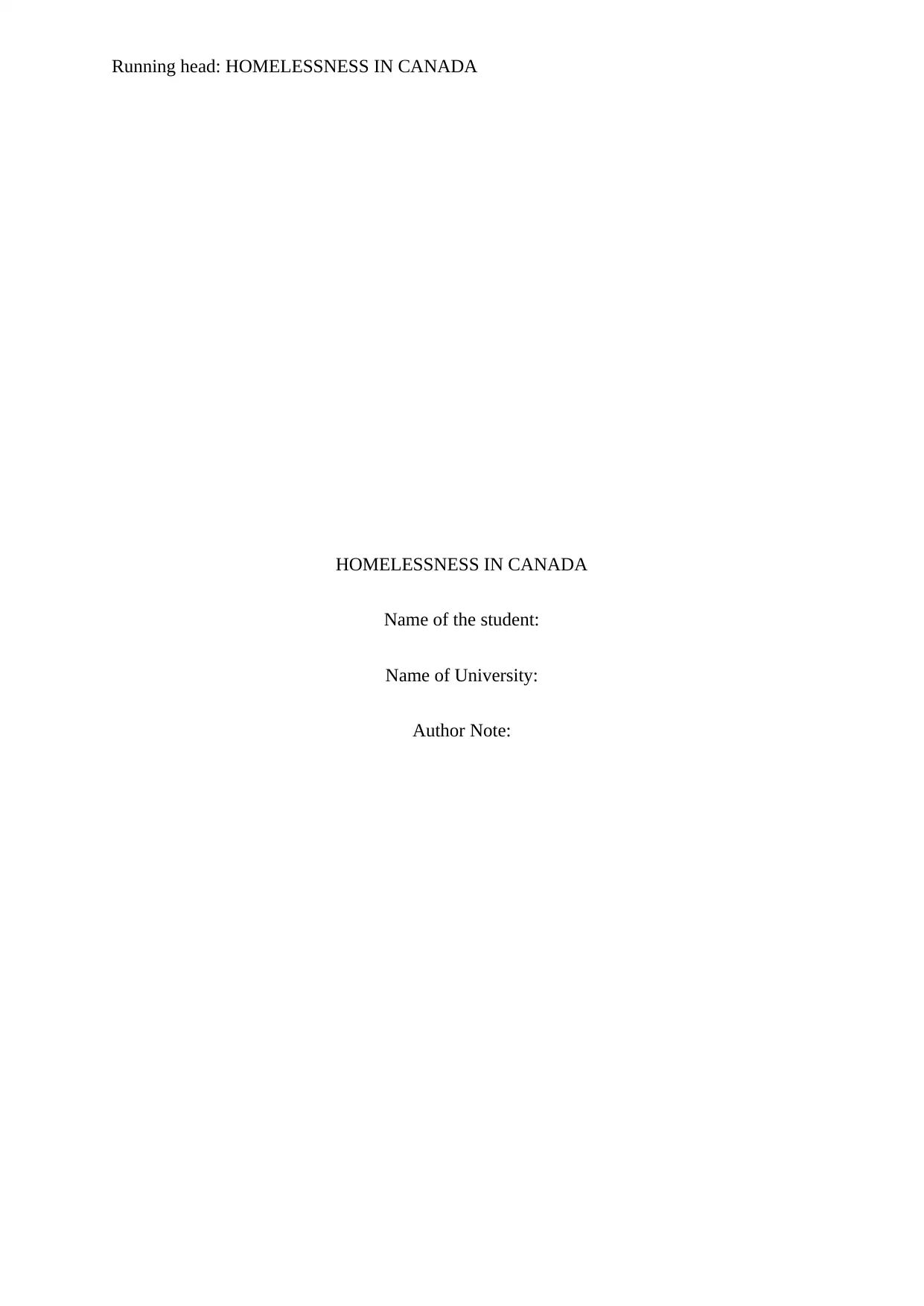
Running head: HOMELESSNESS IN CANADA
HOMELESSNESS IN CANADA
Name of the student:
Name of University:
Author Note:
HOMELESSNESS IN CANADA
Name of the student:
Name of University:
Author Note:
Paraphrase This Document
Need a fresh take? Get an instant paraphrase of this document with our AI Paraphraser
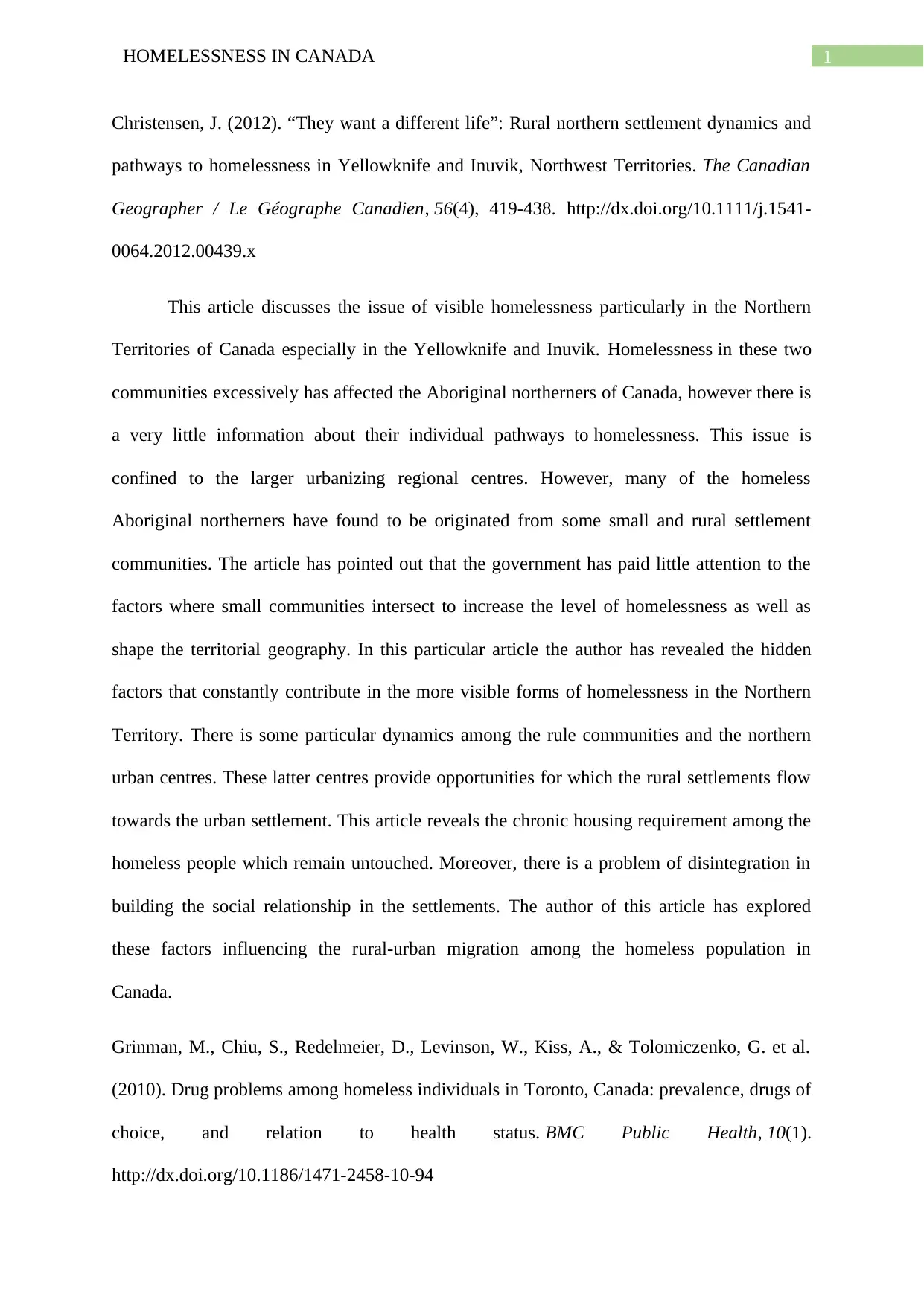
1HOMELESSNESS IN CANADA
Christensen, J. (2012). “They want a different life”: Rural northern settlement dynamics and
pathways to homelessness in Yellowknife and Inuvik, Northwest Territories. The Canadian
Geographer / Le Géographe Canadien, 56(4), 419-438. http://dx.doi.org/10.1111/j.1541-
0064.2012.00439.x
This article discusses the issue of visible homelessness particularly in the Northern
Territories of Canada especially in the Yellowknife and Inuvik. Homelessness in these two
communities excessively has affected the Aboriginal northerners of Canada, however there is
a very little information about their individual pathways to homelessness. This issue is
confined to the larger urbanizing regional centres. However, many of the homeless
Aboriginal northerners have found to be originated from some small and rural settlement
communities. The article has pointed out that the government has paid little attention to the
factors where small communities intersect to increase the level of homelessness as well as
shape the territorial geography. In this particular article the author has revealed the hidden
factors that constantly contribute in the more visible forms of homelessness in the Northern
Territory. There is some particular dynamics among the rule communities and the northern
urban centres. These latter centres provide opportunities for which the rural settlements flow
towards the urban settlement. This article reveals the chronic housing requirement among the
homeless people which remain untouched. Moreover, there is a problem of disintegration in
building the social relationship in the settlements. The author of this article has explored
these factors influencing the rural‐urban migration among the homeless population in
Canada.
Grinman, M., Chiu, S., Redelmeier, D., Levinson, W., Kiss, A., & Tolomiczenko, G. et al.
(2010). Drug problems among homeless individuals in Toronto, Canada: prevalence, drugs of
choice, and relation to health status. BMC Public Health, 10(1).
http://dx.doi.org/10.1186/1471-2458-10-94
Christensen, J. (2012). “They want a different life”: Rural northern settlement dynamics and
pathways to homelessness in Yellowknife and Inuvik, Northwest Territories. The Canadian
Geographer / Le Géographe Canadien, 56(4), 419-438. http://dx.doi.org/10.1111/j.1541-
0064.2012.00439.x
This article discusses the issue of visible homelessness particularly in the Northern
Territories of Canada especially in the Yellowknife and Inuvik. Homelessness in these two
communities excessively has affected the Aboriginal northerners of Canada, however there is
a very little information about their individual pathways to homelessness. This issue is
confined to the larger urbanizing regional centres. However, many of the homeless
Aboriginal northerners have found to be originated from some small and rural settlement
communities. The article has pointed out that the government has paid little attention to the
factors where small communities intersect to increase the level of homelessness as well as
shape the territorial geography. In this particular article the author has revealed the hidden
factors that constantly contribute in the more visible forms of homelessness in the Northern
Territory. There is some particular dynamics among the rule communities and the northern
urban centres. These latter centres provide opportunities for which the rural settlements flow
towards the urban settlement. This article reveals the chronic housing requirement among the
homeless people which remain untouched. Moreover, there is a problem of disintegration in
building the social relationship in the settlements. The author of this article has explored
these factors influencing the rural‐urban migration among the homeless population in
Canada.
Grinman, M., Chiu, S., Redelmeier, D., Levinson, W., Kiss, A., & Tolomiczenko, G. et al.
(2010). Drug problems among homeless individuals in Toronto, Canada: prevalence, drugs of
choice, and relation to health status. BMC Public Health, 10(1).
http://dx.doi.org/10.1186/1471-2458-10-94
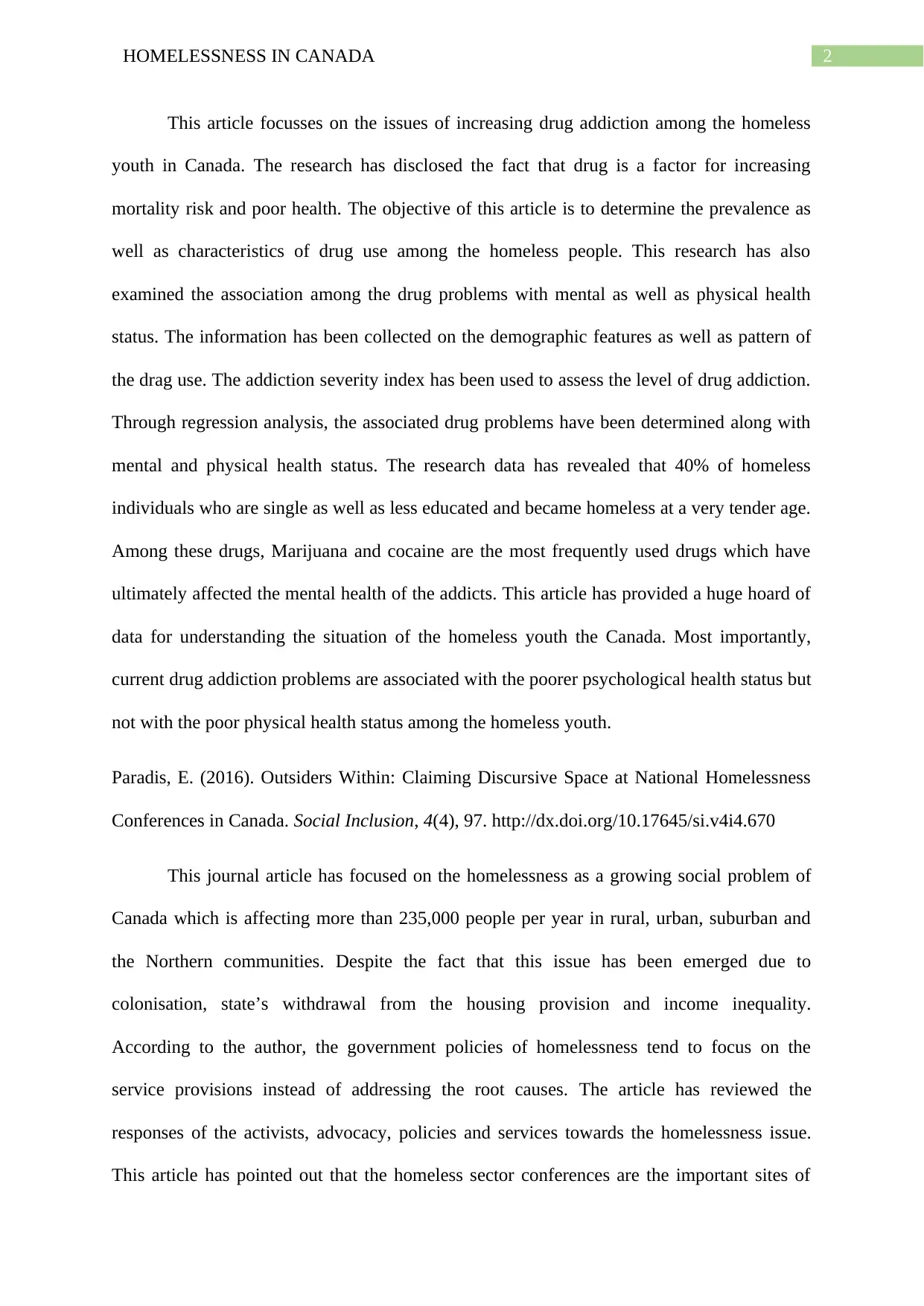
2HOMELESSNESS IN CANADA
This article focusses on the issues of increasing drug addiction among the homeless
youth in Canada. The research has disclosed the fact that drug is a factor for increasing
mortality risk and poor health. The objective of this article is to determine the prevalence as
well as characteristics of drug use among the homeless people. This research has also
examined the association among the drug problems with mental as well as physical health
status. The information has been collected on the demographic features as well as pattern of
the drag use. The addiction severity index has been used to assess the level of drug addiction.
Through regression analysis, the associated drug problems have been determined along with
mental and physical health status. The research data has revealed that 40% of homeless
individuals who are single as well as less educated and became homeless at a very tender age.
Among these drugs, Marijuana and cocaine are the most frequently used drugs which have
ultimately affected the mental health of the addicts. This article has provided a huge hoard of
data for understanding the situation of the homeless youth the Canada. Most importantly,
current drug addiction problems are associated with the poorer psychological health status but
not with the poor physical health status among the homeless youth.
Paradis, E. (2016). Outsiders Within: Claiming Discursive Space at National Homelessness
Conferences in Canada. Social Inclusion, 4(4), 97. http://dx.doi.org/10.17645/si.v4i4.670
This journal article has focused on the homelessness as a growing social problem of
Canada which is affecting more than 235,000 people per year in rural, urban, suburban and
the Northern communities. Despite the fact that this issue has been emerged due to
colonisation, state’s withdrawal from the housing provision and income inequality.
According to the author, the government policies of homelessness tend to focus on the
service provisions instead of addressing the root causes. The article has reviewed the
responses of the activists, advocacy, policies and services towards the homelessness issue.
This article has pointed out that the homeless sector conferences are the important sites of
This article focusses on the issues of increasing drug addiction among the homeless
youth in Canada. The research has disclosed the fact that drug is a factor for increasing
mortality risk and poor health. The objective of this article is to determine the prevalence as
well as characteristics of drug use among the homeless people. This research has also
examined the association among the drug problems with mental as well as physical health
status. The information has been collected on the demographic features as well as pattern of
the drag use. The addiction severity index has been used to assess the level of drug addiction.
Through regression analysis, the associated drug problems have been determined along with
mental and physical health status. The research data has revealed that 40% of homeless
individuals who are single as well as less educated and became homeless at a very tender age.
Among these drugs, Marijuana and cocaine are the most frequently used drugs which have
ultimately affected the mental health of the addicts. This article has provided a huge hoard of
data for understanding the situation of the homeless youth the Canada. Most importantly,
current drug addiction problems are associated with the poorer psychological health status but
not with the poor physical health status among the homeless youth.
Paradis, E. (2016). Outsiders Within: Claiming Discursive Space at National Homelessness
Conferences in Canada. Social Inclusion, 4(4), 97. http://dx.doi.org/10.17645/si.v4i4.670
This journal article has focused on the homelessness as a growing social problem of
Canada which is affecting more than 235,000 people per year in rural, urban, suburban and
the Northern communities. Despite the fact that this issue has been emerged due to
colonisation, state’s withdrawal from the housing provision and income inequality.
According to the author, the government policies of homelessness tend to focus on the
service provisions instead of addressing the root causes. The article has reviewed the
responses of the activists, advocacy, policies and services towards the homelessness issue.
This article has pointed out that the homeless sector conferences are the important sites of
⊘ This is a preview!⊘
Do you want full access?
Subscribe today to unlock all pages.

Trusted by 1+ million students worldwide
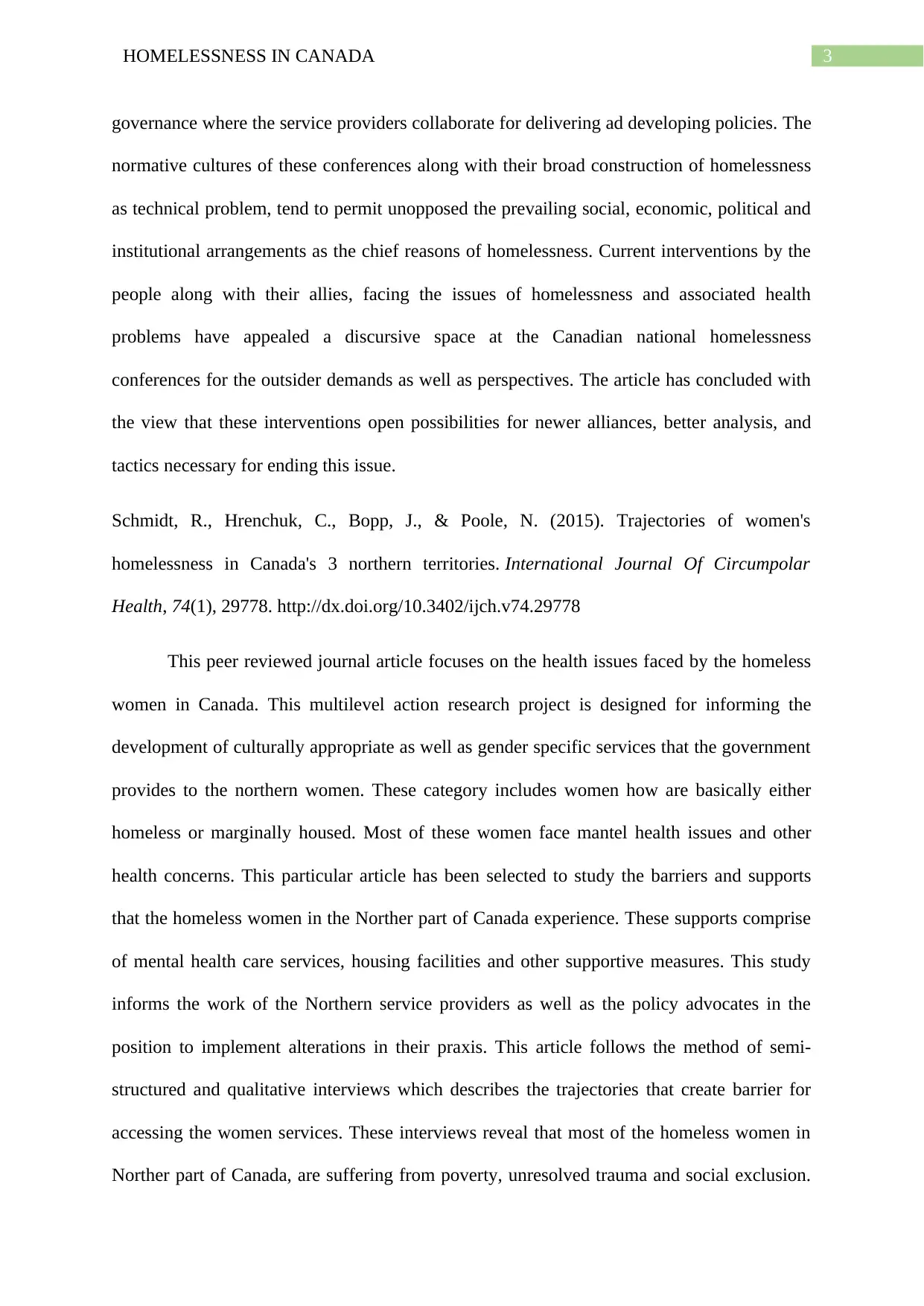
3HOMELESSNESS IN CANADA
governance where the service providers collaborate for delivering ad developing policies. The
normative cultures of these conferences along with their broad construction of homelessness
as technical problem, tend to permit unopposed the prevailing social, economic, political and
institutional arrangements as the chief reasons of homelessness. Current interventions by the
people along with their allies, facing the issues of homelessness and associated health
problems have appealed a discursive space at the Canadian national homelessness
conferences for the outsider demands as well as perspectives. The article has concluded with
the view that these interventions open possibilities for newer alliances, better analysis, and
tactics necessary for ending this issue.
Schmidt, R., Hrenchuk, C., Bopp, J., & Poole, N. (2015). Trajectories of women's
homelessness in Canada's 3 northern territories. International Journal Of Circumpolar
Health, 74(1), 29778. http://dx.doi.org/10.3402/ijch.v74.29778
This peer reviewed journal article focuses on the health issues faced by the homeless
women in Canada. This multilevel action research project is designed for informing the
development of culturally appropriate as well as gender specific services that the government
provides to the northern women. These category includes women how are basically either
homeless or marginally housed. Most of these women face mantel health issues and other
health concerns. This particular article has been selected to study the barriers and supports
that the homeless women in the Norther part of Canada experience. These supports comprise
of mental health care services, housing facilities and other supportive measures. This study
informs the work of the Northern service providers as well as the policy advocates in the
position to implement alterations in their praxis. This article follows the method of semi-
structured and qualitative interviews which describes the trajectories that create barrier for
accessing the women services. These interviews reveal that most of the homeless women in
Norther part of Canada, are suffering from poverty, unresolved trauma and social exclusion.
governance where the service providers collaborate for delivering ad developing policies. The
normative cultures of these conferences along with their broad construction of homelessness
as technical problem, tend to permit unopposed the prevailing social, economic, political and
institutional arrangements as the chief reasons of homelessness. Current interventions by the
people along with their allies, facing the issues of homelessness and associated health
problems have appealed a discursive space at the Canadian national homelessness
conferences for the outsider demands as well as perspectives. The article has concluded with
the view that these interventions open possibilities for newer alliances, better analysis, and
tactics necessary for ending this issue.
Schmidt, R., Hrenchuk, C., Bopp, J., & Poole, N. (2015). Trajectories of women's
homelessness in Canada's 3 northern territories. International Journal Of Circumpolar
Health, 74(1), 29778. http://dx.doi.org/10.3402/ijch.v74.29778
This peer reviewed journal article focuses on the health issues faced by the homeless
women in Canada. This multilevel action research project is designed for informing the
development of culturally appropriate as well as gender specific services that the government
provides to the northern women. These category includes women how are basically either
homeless or marginally housed. Most of these women face mantel health issues and other
health concerns. This particular article has been selected to study the barriers and supports
that the homeless women in the Norther part of Canada experience. These supports comprise
of mental health care services, housing facilities and other supportive measures. This study
informs the work of the Northern service providers as well as the policy advocates in the
position to implement alterations in their praxis. This article follows the method of semi-
structured and qualitative interviews which describes the trajectories that create barrier for
accessing the women services. These interviews reveal that most of the homeless women in
Norther part of Canada, are suffering from poverty, unresolved trauma and social exclusion.
Paraphrase This Document
Need a fresh take? Get an instant paraphrase of this document with our AI Paraphraser
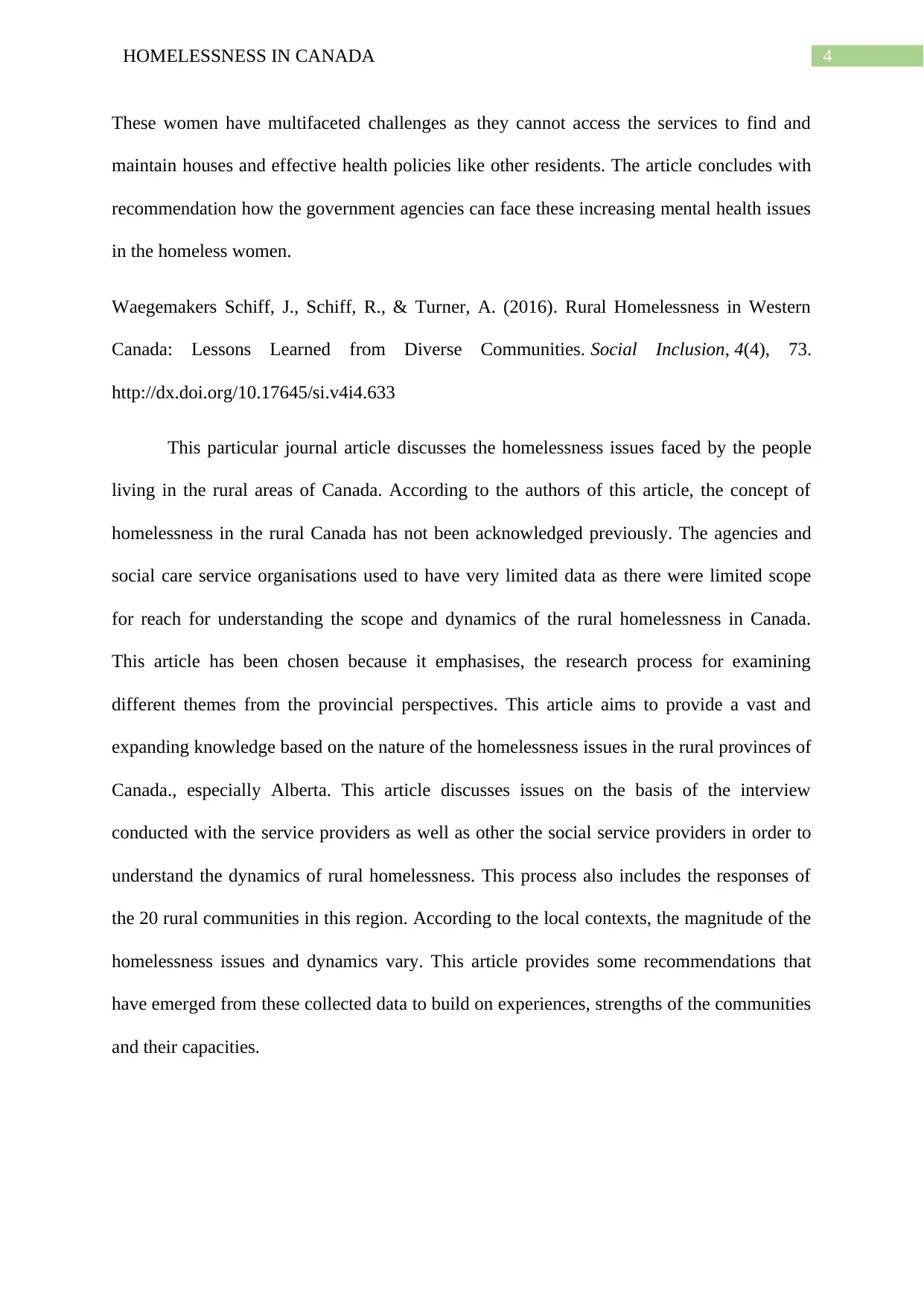
4HOMELESSNESS IN CANADA
These women have multifaceted challenges as they cannot access the services to find and
maintain houses and effective health policies like other residents. The article concludes with
recommendation how the government agencies can face these increasing mental health issues
in the homeless women.
Waegemakers Schiff, J., Schiff, R., & Turner, A. (2016). Rural Homelessness in Western
Canada: Lessons Learned from Diverse Communities. Social Inclusion, 4(4), 73.
http://dx.doi.org/10.17645/si.v4i4.633
This particular journal article discusses the homelessness issues faced by the people
living in the rural areas of Canada. According to the authors of this article, the concept of
homelessness in the rural Canada has not been acknowledged previously. The agencies and
social care service organisations used to have very limited data as there were limited scope
for reach for understanding the scope and dynamics of the rural homelessness in Canada.
This article has been chosen because it emphasises, the research process for examining
different themes from the provincial perspectives. This article aims to provide a vast and
expanding knowledge based on the nature of the homelessness issues in the rural provinces of
Canada., especially Alberta. This article discusses issues on the basis of the interview
conducted with the service providers as well as other the social service providers in order to
understand the dynamics of rural homelessness. This process also includes the responses of
the 20 rural communities in this region. According to the local contexts, the magnitude of the
homelessness issues and dynamics vary. This article provides some recommendations that
have emerged from these collected data to build on experiences, strengths of the communities
and their capacities.
These women have multifaceted challenges as they cannot access the services to find and
maintain houses and effective health policies like other residents. The article concludes with
recommendation how the government agencies can face these increasing mental health issues
in the homeless women.
Waegemakers Schiff, J., Schiff, R., & Turner, A. (2016). Rural Homelessness in Western
Canada: Lessons Learned from Diverse Communities. Social Inclusion, 4(4), 73.
http://dx.doi.org/10.17645/si.v4i4.633
This particular journal article discusses the homelessness issues faced by the people
living in the rural areas of Canada. According to the authors of this article, the concept of
homelessness in the rural Canada has not been acknowledged previously. The agencies and
social care service organisations used to have very limited data as there were limited scope
for reach for understanding the scope and dynamics of the rural homelessness in Canada.
This article has been chosen because it emphasises, the research process for examining
different themes from the provincial perspectives. This article aims to provide a vast and
expanding knowledge based on the nature of the homelessness issues in the rural provinces of
Canada., especially Alberta. This article discusses issues on the basis of the interview
conducted with the service providers as well as other the social service providers in order to
understand the dynamics of rural homelessness. This process also includes the responses of
the 20 rural communities in this region. According to the local contexts, the magnitude of the
homelessness issues and dynamics vary. This article provides some recommendations that
have emerged from these collected data to build on experiences, strengths of the communities
and their capacities.
1 out of 5
Your All-in-One AI-Powered Toolkit for Academic Success.
+13062052269
info@desklib.com
Available 24*7 on WhatsApp / Email
![[object Object]](/_next/static/media/star-bottom.7253800d.svg)
Unlock your academic potential
Copyright © 2020–2025 A2Z Services. All Rights Reserved. Developed and managed by ZUCOL.
